A Contagious… Smile! Training Emotional Skills of Adults with Intellectual Disability in the Time of COVID-19
Abstract
1. Introduction
1.1. COVID-19 and Intellectual Disability
1.2. Emotions and Intellectual Disability
1.3. Aims and Hypotheses
- (1)
- To find a feeling of fear and isolation before the training program;
- (2)
- That the training could be effective in encouraging cognitive reappraisal of emotional experiences. In detail, we predicted participants would report experiencing less negative emotion, particularly fear, and to improve their ability to express feelings freely.
- (3)
- To observe a new feeling of support and higher awareness after the training.
2. Materials and Methods
2.1. Participants
2.2. Instruments
2.2.1. Assessment of Emotion
2.2.2. Appreciation Survey
2.2.3. Training Program
2.2.4. Procedure
3. Quantitative Analysis
Results and Discussion
4. Qualitative Analysis
Results and Discussion
5. General Discussion
6. Conclusions
Author Contributions
Funding
Institutional Review Board Statement
Informed Consent Statement
Data Availability Statement
Acknowledgments
Conflicts of Interest
References
- World Health Organization. WHO Coronavirus (COVID-19); WHO: Geneva, Switzerland, 2023; Available online: https://covid19.who.int/ (accessed on 29 January 2023).
- Makary, M. Risk Factors for COVID-19 Mortality among Privately Insured Patients; FAIR Health: New York, NY, USA, 2020. [Google Scholar]
- Gleason, J.; Ross, W.; Fossi, A.; Blonsky, H.; Tobias, J.; Stephens, M. The Devastating Impact of COVID-19 on Individuals with Intellectual Disabilities in the United States. NEJM Catal. Innov. Care Deliv. 2021, 2, 1–12. [Google Scholar] [CrossRef]
- Rathod, S.; Pallikadavath, S.; Young, A.H.; Graves, L.; Rahman, M.M.; Brooks, A.; Soomro, M.; Rathod, P.; Phiri, P. Psychological Impact of COVID-19 Pandemic: Protocol and Results of First Three Weeks from an International Cross-Section Survey-Focus on Health Professionals. J. Affect. Disord. Rep. 2020, 1, 100005. [Google Scholar] [CrossRef] [PubMed]
- Copeland, W.E.; McGinnis, E.; Bai, Y.; Adams, Z.; Nardone, H.; Devadanam, V.; Rettew, J.; Hudziak, J.J. Impact of COVID-19 Pandemic on College Student Mental Health and Wellness. J. Am. Acad. Child Adolesc. Psychiatry 2021, 60, 134–141. [Google Scholar] [PubMed]
- Medda, E.; Toccaceli, V.; Gigantesco, A.; Picardi, A.; Fagnani, C.; Stazi, M.A. The COVID-19 Pandemic in Italy: Depressive Symptoms Immediately before and after the First Lockdown. J. Affect. Disord. 2022, 298, 202–208. [Google Scholar] [CrossRef]
- Manchia, M.; Gathier, A.W.; Yapici-Eser, H.; Schmidt, M.V.; de Quervain, D.; van Amelsvoort, T.; Bisson, J.I.; Cryan, J.F.; Howes, O.D.; Pinto, L. The Impact of the Prolonged COVID-19 Pandemic on Stress Resilience and Mental Health: A Critical Review across Waves. Eur. Neuropsychopharmacol. 2022, 55, 22–83. [Google Scholar]
- Schuengel, C.; Tummers, J.; Embregts, P.J.C.M.; Leusink, G.L. Impact of the Initial Response to COVID-19 on Long-Term Care for People with Intellectual Disability: An Interrupted Time Series Analysis of Incident Reports. J. Intellect. Disabil. Res. 2020, 64, 817–824. [Google Scholar] [CrossRef]
- Embregts, P.J.C.M.; van den Bogaard, K.J.H.M.; Frielink, N.; Voermans, M.A.C.; Thalen, M.; Jahoda, A. A Thematic Analysis into the Experiences of People with a Mild Intellectual Disability during the COVID-19 Lockdown Period. Int. J. Dev. Disabil. 2022, 68, 578–582. [Google Scholar] [CrossRef]
- Courtenay, K.; Perera, B. COVID-19 and People with Intellectual Disability: Impacts of a Pandemic. Ir. J. Psychol. Med. 2020, 37, 231–236. [Google Scholar] [CrossRef]
- Dhiman, S.; Sahu, P.K.; Reed, W.R.; Ganesh, G.S.; Goyal, R.K.; Jain, S. Impact of COVID-19 Outbreak on Mental Health and Perceived Strain among Caregivers Tending Children with Special Needs. Res. Dev. Disabil. 2020, 107, 103790. [Google Scholar] [CrossRef]
- Fontanesi, L.; Marchetti, D.; Mazza, C.; Di Giandomenico, S.; Roma, P.; Verrocchio, M.C. The Effect of the COVID-19 Lockdown on Parents: A Call to Adopt Urgent Measures. Psychol. Trauma Theory Res. Pract. Policy 2020, 12, S79. [Google Scholar] [CrossRef]
- Willner, P.; Rose, J.; Stenfert Kroese, B.; Murphy, G.H.; Langdon, P.E.; Clifford, C.; Hutchings, H.; Watkins, A.; Hiles, S.; Cooper, V. Effect of the COVID-19 Pandemic on the Mental Health of Carers of People with Intellectual Disabilities. J. Appl. Res. Intellect. Disabil. 2020, 33, 1523–1533. [Google Scholar] [CrossRef] [PubMed]
- Bailey, T.; Hastings, R.P.; Totsika, V. COVID-19 Impact on Psychological Outcomes of Parents, Siblings and Children with Intellectual Disability: Longitudinal before and during Lockdown Design. J. Intellect. Disabil. Res. 2021, 65, 397–404. [Google Scholar] [CrossRef]
- Taggart, L.; Truesdale-Kennedy, M.; Ryan, A.; McConkey, R. Examining the Support Needs of Ageing Family Carers in Developing Future Plans for a Relative with an Intellectual Disability. J. Intellect. Disabil. 2012, 16, 217–234. [Google Scholar] [CrossRef] [PubMed]
- McCausland, D.; Luus, R.; McCallion, P.; Murphy, E.; McCarron, M. The Impact of COVID-19 on the Social Inclusion of Older Adults with an Intellectual Disability during the First Wave of the Pandemic in Ireland. J. Intellect. Disabil. Res. 2021, 65, 879–889. [Google Scholar] [CrossRef] [PubMed]
- Lysaght, R.; Ouellette-Kuntz, H.; Morrison, C. Meaning and Value of Productivity to Adults with Intellectual Disabilities. J. Intellect. Dev. Disabil. 2009, 47, 413–424. [Google Scholar] [CrossRef] [PubMed]
- Lysaght, R.; Petner-Arrey, J.; Howell-Moneta, A.; Cobigo, V. Inclusion through Work and Productivity for Persons with Intellectual and Developmental Disabilities. J. Appl. Res. Intellect. Disabil. 2017, 30, 922–935. [Google Scholar] [CrossRef]
- Sappok, T.; Heinrich, M.; Böhm, J. The Impact of Emotional Development in People with Autism Spectrum Disorder and Intellectual Developmental Disability. J. Intellect. Disabil. Res. 2020, 64, 946–955. [Google Scholar] [CrossRef]
- Bermejo, B.G.; Mateos, P.M.; Sánchez-Mateos, J.D. The Emotional Experience of People with Intellectual Disability: An Analysis Using the International Affective Pictures System. Am. J. Intellect. Dev. Disabil. 2014, 119, 371–384. [Google Scholar] [CrossRef]
- Murray, G.; McKenzie, K.; Murray, A.; Whelan, K.; Cossar, J.; Murray, K.; Scotland, J. The Impact of Contextual Information on the Emotion Recognition of Children with an Intellectual Disability. J. Appl. Res. Intellect. Disabil. 2019, 32, 152–158. [Google Scholar] [CrossRef]
- Wishart, J.G.; Cebula, K.R.; Willis, D.S.; Pitcairn, T.K. Understanding of Facial Expressions of Emotion by Children with Intellectual Disabilities of Differing Aetiology. J. Intellect. Disabil. Res. 2007, 51, 551–563. [Google Scholar] [CrossRef]
- Memisevic, H.; Mujkanovic, E.; Ibralic-Biscevic, I. Facial Emotion Recognition in Adolescents with Disabilities: The Effects of Type of Disability and Gender. Percept. Mot. Ski. 2016, 123, 127–137. [Google Scholar] [CrossRef] [PubMed]
- Marsh, N.V.; Ng, S.H. Behavioural and Emotional Functioning of Adolescents with Mild Intellectual Disability: Perspectives from Home and School. J. Psychol. Educ. 2017, 12, 76–84. [Google Scholar] [CrossRef]
- Scotland, J.L.; Cossar, J.; McKenzie, K. The Ability of Adults with an Intellectual Disability to Recognise Facial Expressions of Emotion in Comparison with Typically Developing Individuals: A Systematic Review. Res. Dev. Disabil. 2015, 41, 22–39. [Google Scholar] [CrossRef] [PubMed]
- Scotland, J.L.; McKenzie, K.; Cossar, J.; Murray, A.; Michie, A. Recognition of Facial Expressions of Emotion by Adults with Intellectual Disability: Is There Evidence for the Emotion Specificity Hypothesis? Res. Dev. Disabil. 2016, 48, 69–78. [Google Scholar] [CrossRef]
- Andrés-Roqueta, C.; Soria-Izquierdo, E.; Górriz-Plumed, A.B. Exploring Different Aspects of Emotion Understanding in Adults with Down Syndrome. Res. Dev. Disabil. 2021, 114, 103962. [Google Scholar] [CrossRef]
- Rojahn, J.; Rabold, D.E.; Schneider, F. Emotion Specificity in Mental Retardation. Am. J. Ment. Retard. 1995, 99, 477–486. [Google Scholar] [PubMed]
- Moore, D.G. Reassessing Emotion Recognition Performance in People with Mental Retardation: A Review. Am. J. Ment. Retard. 2001, 106, 481–502. [Google Scholar] [CrossRef]
- Moffatt, C.W.; Hanley-Maxwell, C.; Donnellan, A.M. Discrimination of Emotion, Affective Perspective-Taking and Empathy in Individuals with Mental Retardation. Educ. Train. Ment. Retard. Dev. Disabil. 1995, 30, 76–85. [Google Scholar]
- McKown, C.; Allen, A.M.; Russo-Ponsaran, N.M.; Johnson, J.K. Direct Assessment of Children’s Social-Emotional Comprehension. Psychol. Assess. 2013, 25, 1154. [Google Scholar] [CrossRef]
- La Malfa, G.; Lassi, S.; Bertelli, M.; Albertini, G.; Dosen, A. Emotional Development and Adaptive Abilities in Adults with Intellectual Disability. A Correlation Study between the Scheme of Appraisal of Emotional Development (SAED) and Vineland Adaptive Behavior Scale (VABS). Res. Dev. Disabil. 2009, 30, 1406–1412. [Google Scholar] [CrossRef]
- Wood, P.M.; Kroese, B.S. Enhancing the Emotion Recognition Skills of Individuals with Learning Disabilities: A Review of the Literature. J. Appl. Res. Intellect. Disabil. 2007, 20, 576–579. [Google Scholar] [CrossRef]
- Downs, A.; Strand, P. Effectiveness of Emotion Recognition Training for Young Children’s with Developmental Delays. J. Early Intensive Behav. Interv. 2008, 5, 75. [Google Scholar] [CrossRef]
- Safitri, S.; Salim, R.M.A.; Widyasari, P. The Effectiveness of Dialectical Behavior Therapy in Developing Emotion Regulation Skill for Adolescent with Intellectual Disability. In Proceedings of the 3rd International Conference on Psychology in Health, Educational, Social, and Organizational Settings—ICP-HESOS, Surabaya, Indonesia, 16–18 November 2018; pp. 351–359. [Google Scholar] [CrossRef]
- Safitri, S. Enhancing Adolescent’s Emotion Regulation with Dialectical Behavior Therapy’s Skill Training: The Applications across Borderline, Mild, and Moderate Intellectual Disability. J. Intellect. Disabil. Treat. 2020, 8, 244–253. [Google Scholar] [CrossRef]
- Adibsereshki, N.; Shaydaei, M.; Movallali, G. The Effectiveness of Emotional Intelligence Training on the Adaptive Behaviors of Students with Intellectual Disability. Int. J. Dev. Disabil. 2016, 62, 245–252. [Google Scholar] [CrossRef]
- Rydin-Orwin, T.; Drake, J.; Bratt, A. The Effects of Training on Emotion Recognition Skills for Adults with an Intellectual Disability. J. Appl. Res. Intellect. Disabil. 1999, 12, 253–262. [Google Scholar] [CrossRef]
- Mcalpine, C.; Singh, N.N.; Ellis, C.R.; Kendall, K.A.; Hampton, C. Enhancing the Ability of Adults with Mental Retardation to Recognize Facial Expressions of Emotion. Behav. Modif. 1992, 16, 559–573. [Google Scholar] [CrossRef]
- Kelley, K.R.; Hurry, K.; Clark, K.A. Effects of Social-Emotional Skills Training Through Computer-Assisted Instruction for Young Adults with Intellectual Disability. Rev. Disabil. Stud. Int. J. 2021, 17, 1–37. [Google Scholar]
- Vanutelli, M.E.; Cortinovis, V.; Lucchiari, C. The relationship between creative, cognitive, and emotional competences in Intellectual Disability: A case report. Life Span Disabil. 2022, 25, 121–149. [Google Scholar]
- Pons, F.; Harris, P. Test of Emotion Comprehension: TEC; University of Oxford: Oxford, UK, 2000. [Google Scholar]
- Albanese, O.; Molina, P. The Development of Emotion Comprehension and Its Assessment; The Italian Standardization of the Test of Emotion Comprehension (TEC); UNICOPLI: Milano, Italy, 2008. [Google Scholar]
- Cavioni, V.; Grazzani, I.; Ornaghi, V.; Pepe, A.; Pons, F. Assessing the Factor Structure and Measurement Invariance of the Test of Emotion Comprehension (TEC): A Large Cross-Sectional Study with Children Aged 3–10 Years. J. Cogn. Dev. 2020, 21, 406–424. [Google Scholar] [CrossRef]
- Laurent, J.; Catanzaro, S.J.; Joiner Jr, T.E.; Rudolph, K.D.; Potter, K.I.; Lambert, S.; Osborne, L.; Gathright, T. A Measure of Positive and Negative Affect for Children: Scale Development and Preliminary Validation. Psychol. Assess. 1999, 11, 326. [Google Scholar] [CrossRef]
- Ciarrochi, J.V.; Deane, F.P.; Bajgar, J.; Lane, R. Development of the Levels of Emotional Awareness Scale for Children (LEAS-C). Br. J. Dev. Psychol. 2005, 23, 569–586. [Google Scholar] [CrossRef]
- Lane, R.D.; Quinlan, D.M.; Schwartz, G.E.; Walker, P.A.; Zeitlin, S.B. The Levels of Emotional Awareness Scale: A Cognitive-Developmental Measure of Emotion. J. Personal. Assess. 1990, 55, 124–134. [Google Scholar] [CrossRef] [PubMed]
- Marchetti, A.; Castelli, I.; Massaro, D.; Valle, A. La Consapevolezza Emotiva in Età Scolastica: Un Contributo Alla Validazione Italiana Della LEAS-C. In Ricerche di Psicologia; Franco Angeli: Milan, Italy, 2010; Volume 4, pp. 555–574. [Google Scholar] [CrossRef]
- Di Pietro, M.; Dacomo, M. Giochi e Attività Sulle Emozioni. Nuovi Materiali per L’educazione Razionale-Emotiva; Edizioni Erickson: Trento, Italy, 2007; ISBN 8861370020. [Google Scholar]
- Sunderland, M. Aiutare i Bambini a Esprimere Le Emozioni; Edizioni Erickson: Trento, Italy, 2005. [Google Scholar]
- De Gregorio, A. Arteterapia: Il Modello Polisegnico. In Arti Terapie. I Fondamenti Teorici; Palazzi, C., Taverna, A., Eds.; Tirrenia Stampatori: Torino, Italy, 2000. [Google Scholar]
- Arnheim, R. Arte e Percezione Visiva Art and Visual Perception: A Psychology of the Creative Eye; Giangiacomo Feltrinelli Editore: Milan, Italy, 1971. [Google Scholar]
- Palazzi Trivelli, C.; Taverna, A. Arti Terapie, i Fondamenti; Tirrenia Stampatori: Torino, Italy, 2000. [Google Scholar]
- Vanutelli, M.E. Special Creativity and School Inclusion (Creatività Speciale e Inclusione Scolastica). In Creativity at School (Creatività a Scuola); Lucchiari, C., Vanutelli, M.E., Eds.; Libreria Universitaria Edizioni: Padova, Italy, 2020. [Google Scholar]
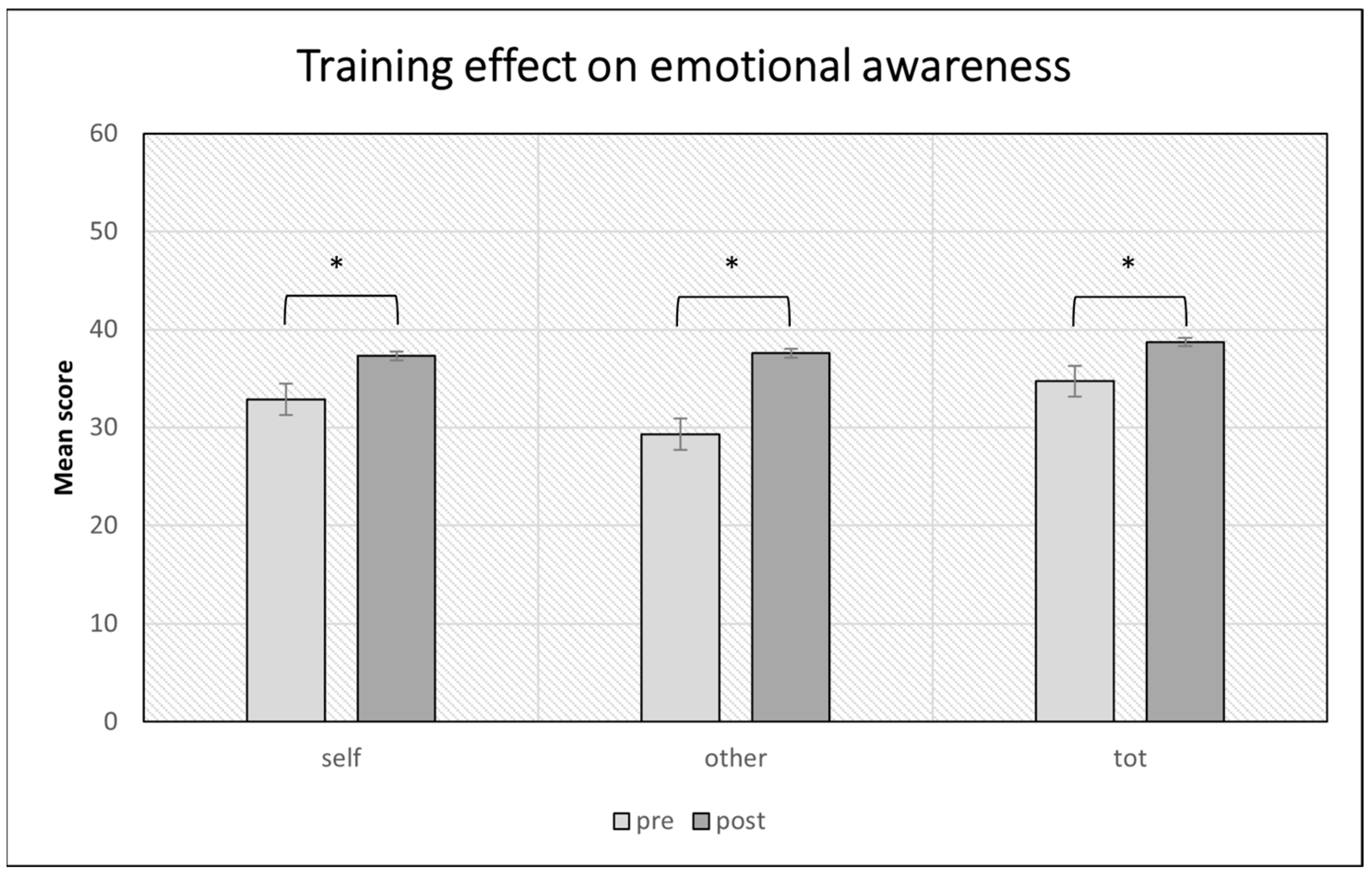
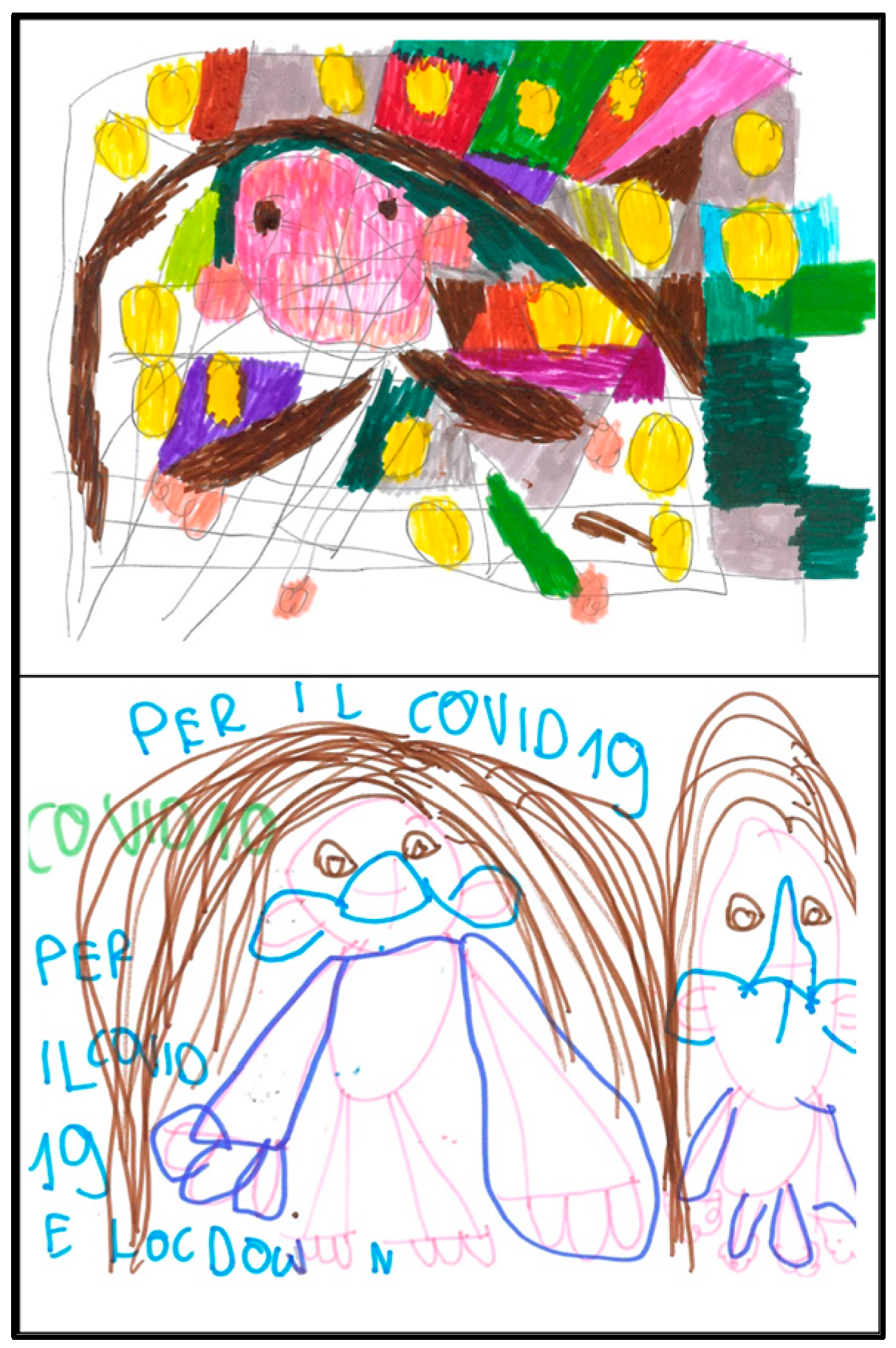
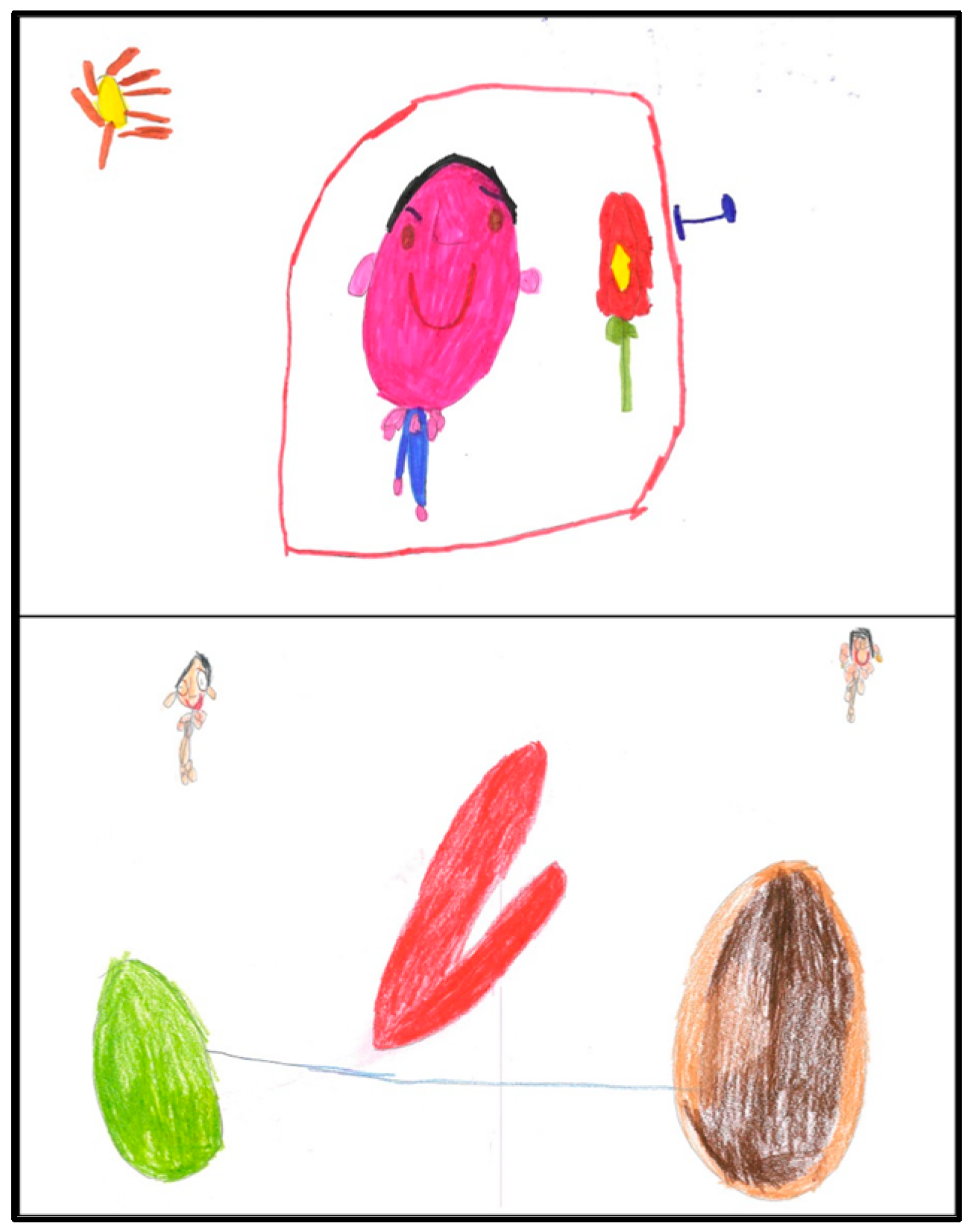
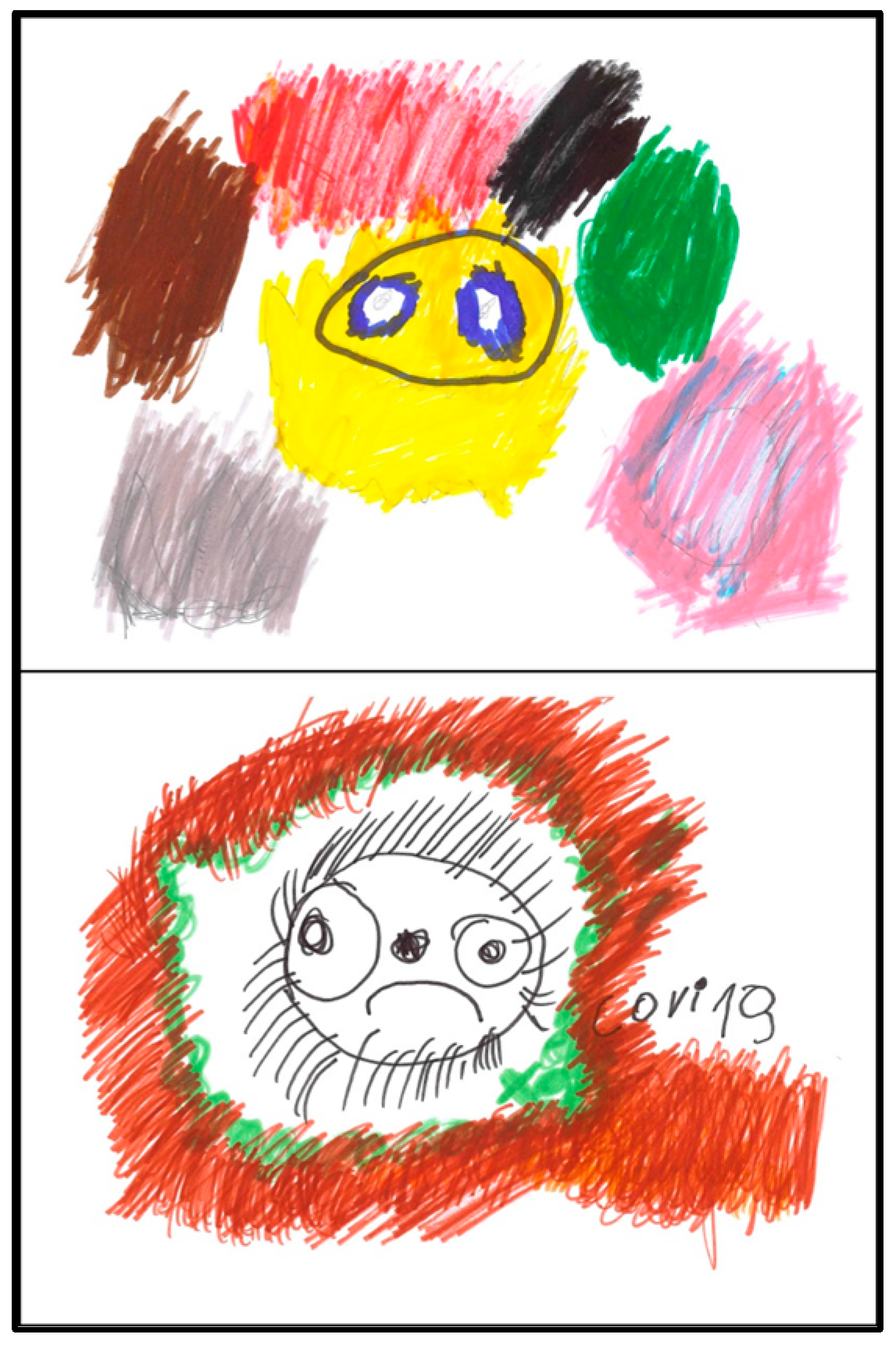
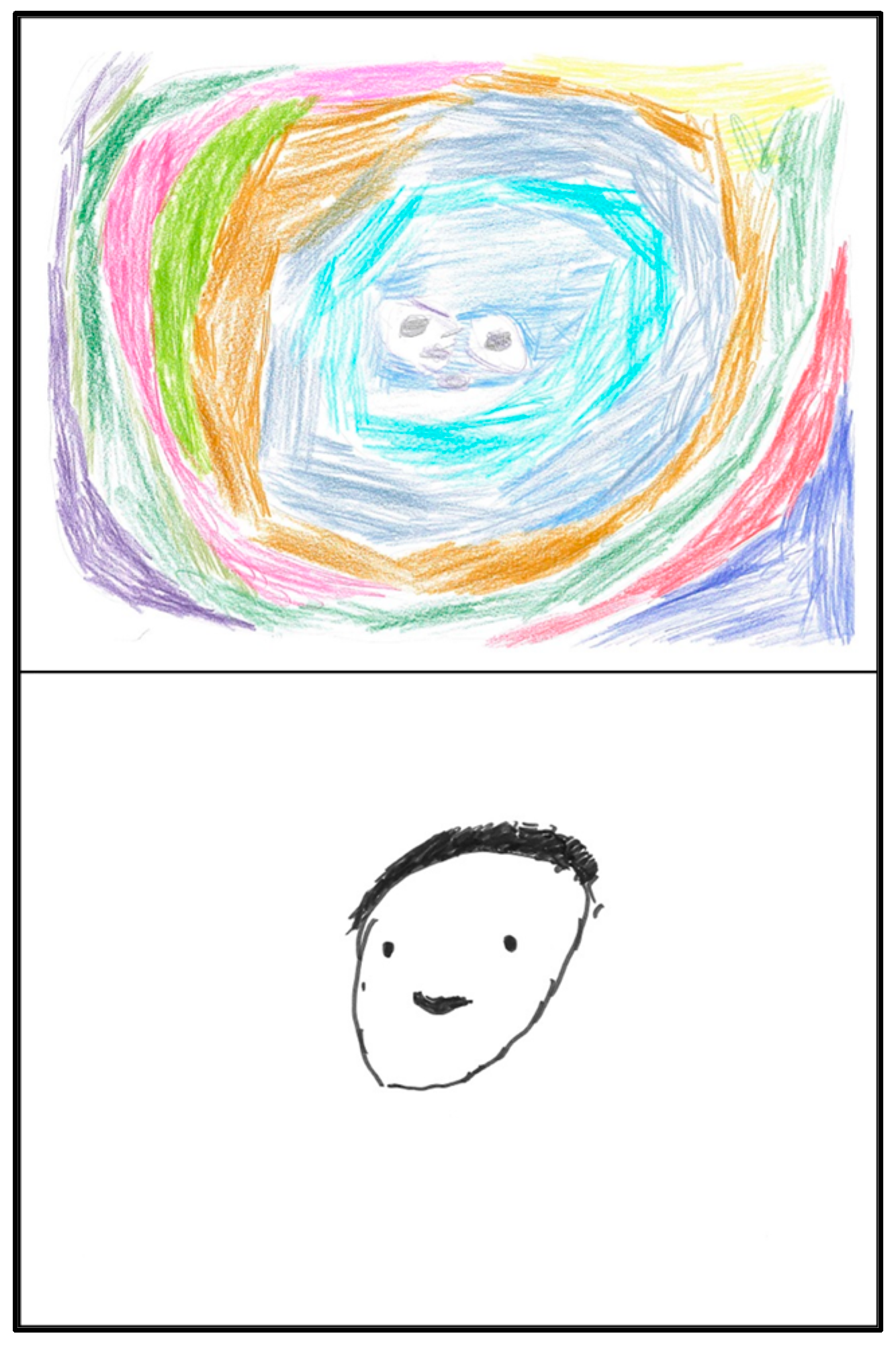
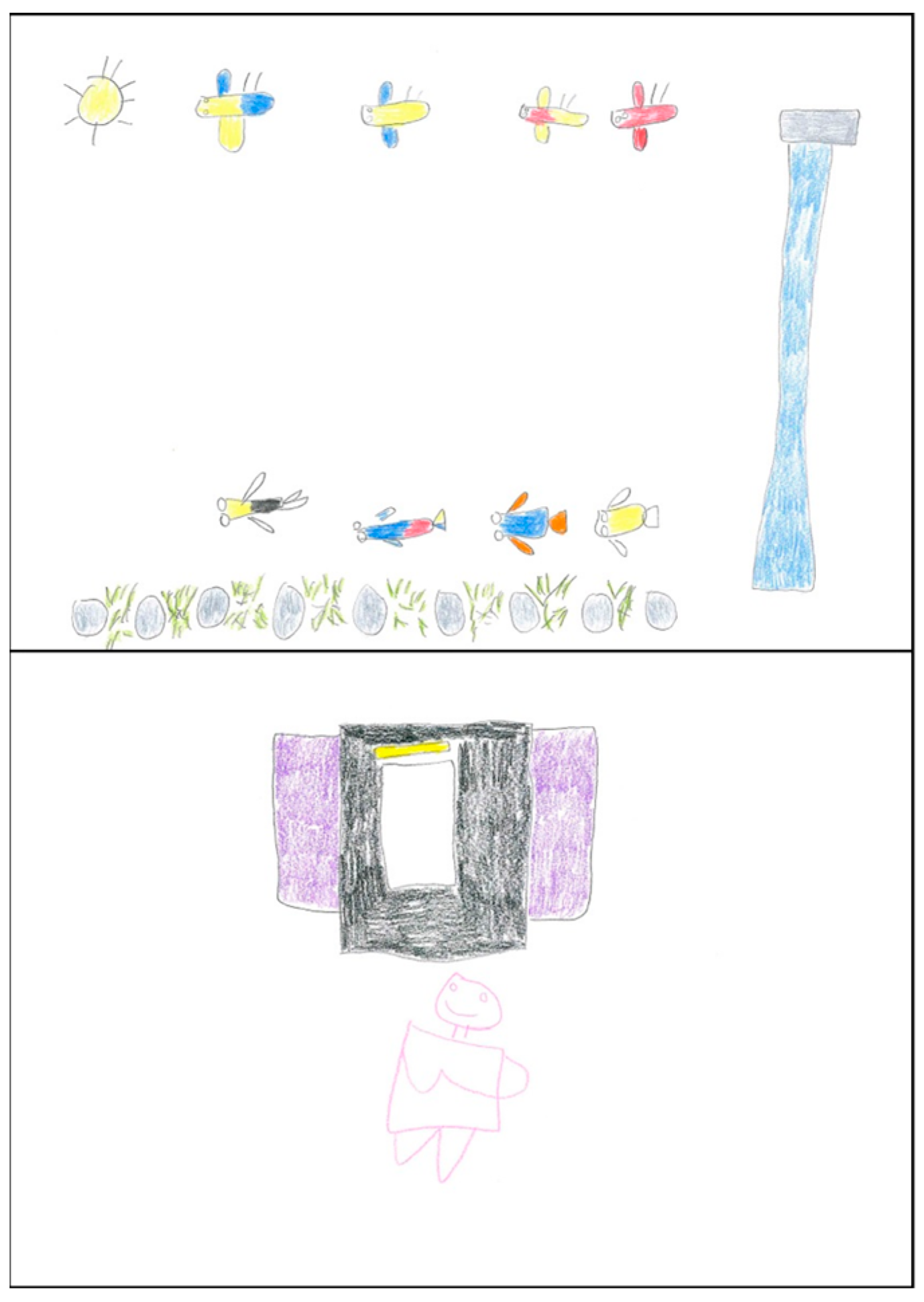
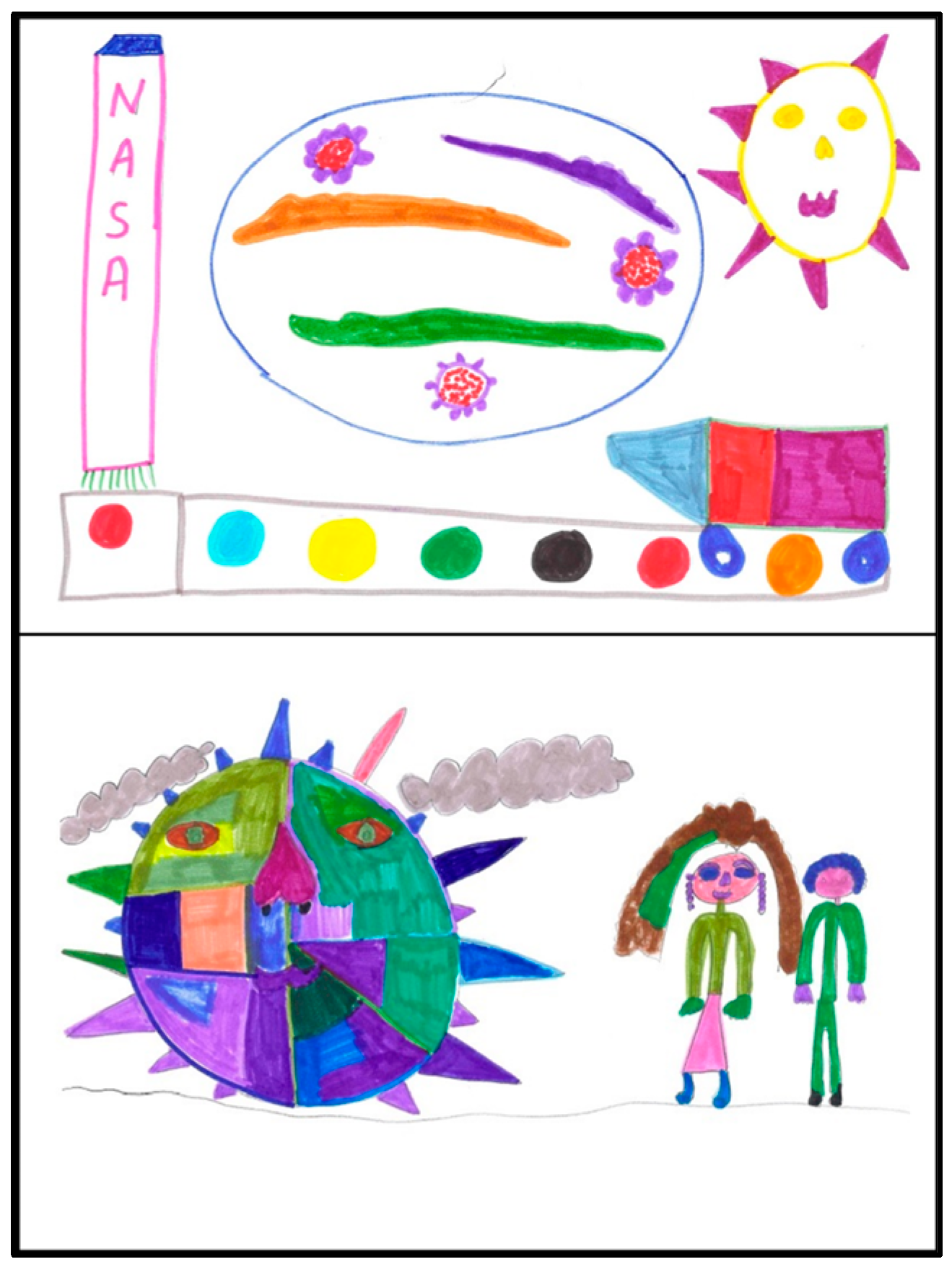
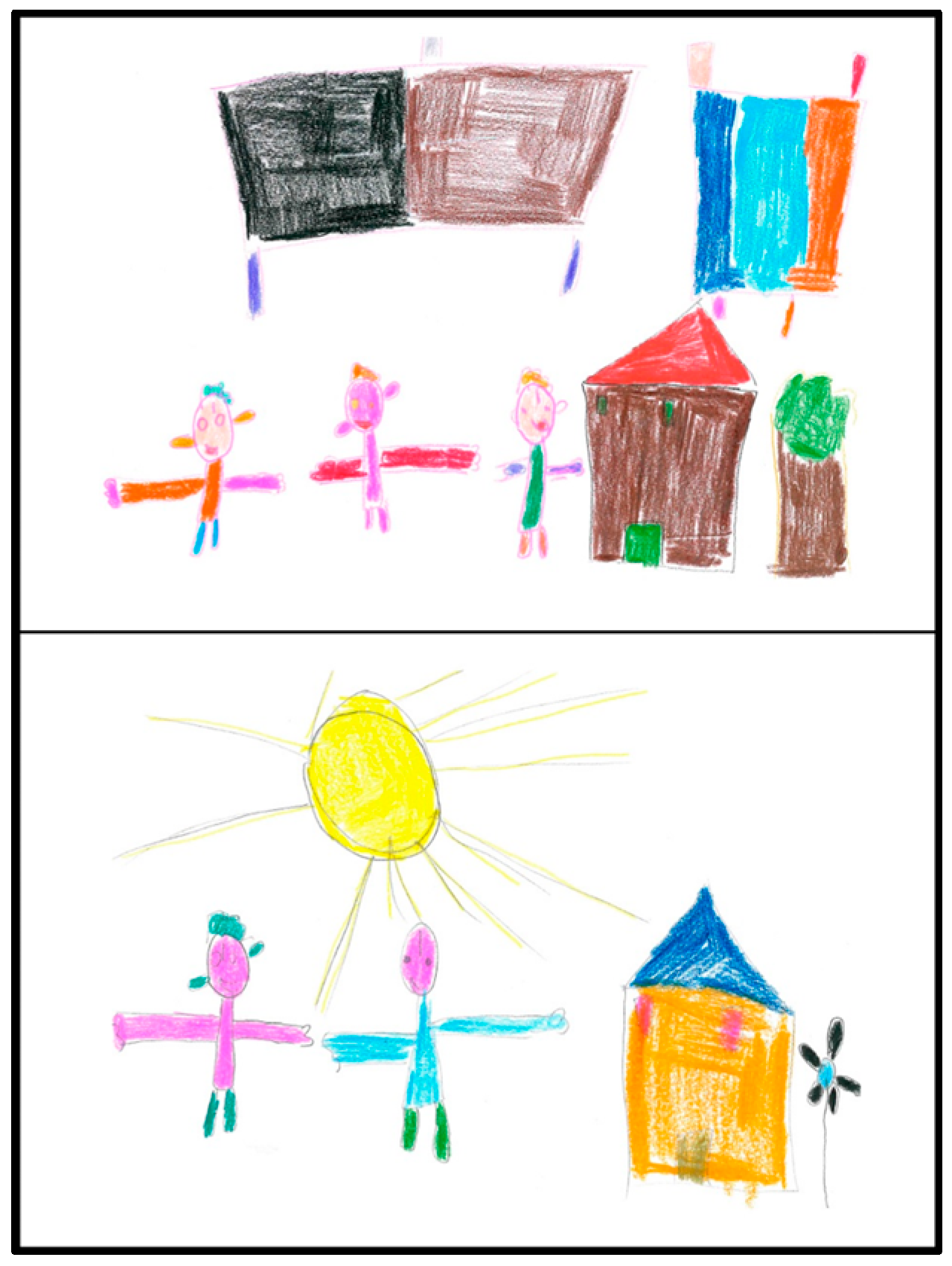
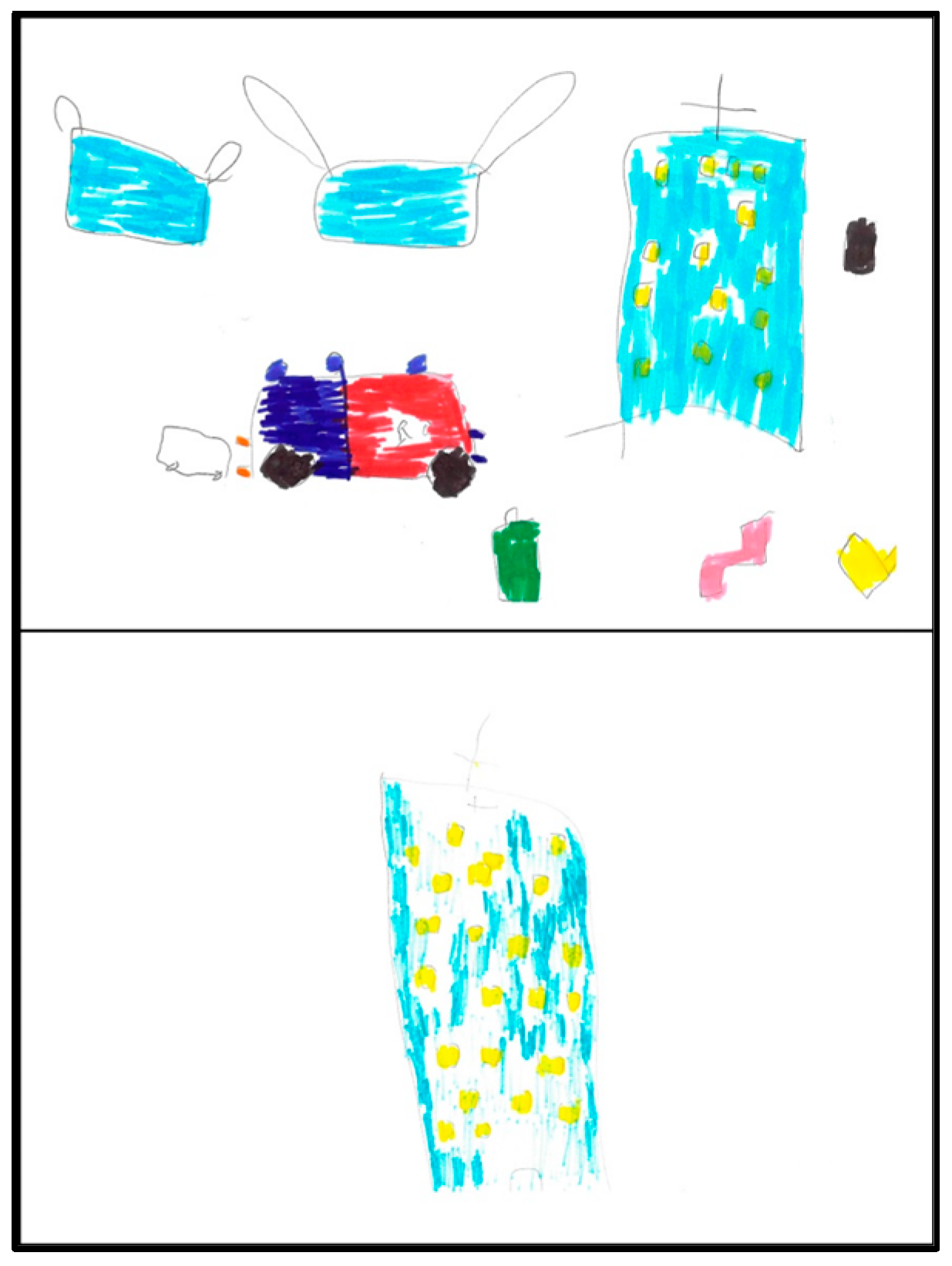
| Answer | ||||||
|---|---|---|---|---|---|---|
| Question | Not At All | Not Much | So-So | Enough | A Lot | Very Much |
| How much did you enjoy the emotional training? | 0% | 0% | 0% | 12.5% | 25% | 62.5% |
| How much did you enjoy working in groups with your mates? | 0% | 0% | 12.5% | 0% | 12.5% | 75% |
| Do you feel you learned new things? | 0% | 0% | 0% | 12.5% | 37.5% | 50% |
| Would you like to do similar activities in the future? | 0% | 0% | 0% | 0% | 0% | 100% |
Disclaimer/Publisher’s Note: The statements, opinions and data contained in all publications are solely those of the individual author(s) and contributor(s) and not of MDPI and/or the editor(s). MDPI and/or the editor(s) disclaim responsibility for any injury to people or property resulting from any ideas, methods, instructions or products referred to in the content. |
© 2023 by the authors. Licensee MDPI, Basel, Switzerland. This article is an open access article distributed under the terms and conditions of the Creative Commons Attribution (CC BY) license (https://creativecommons.org/licenses/by/4.0/).
Share and Cite
Vanutelli, M.E.; Grieco, A.; Comelli, E.; Lucchiari, C. A Contagious… Smile! Training Emotional Skills of Adults with Intellectual Disability in the Time of COVID-19. Educ. Sci. 2023, 13, 149. https://doi.org/10.3390/educsci13020149
Vanutelli ME, Grieco A, Comelli E, Lucchiari C. A Contagious… Smile! Training Emotional Skills of Adults with Intellectual Disability in the Time of COVID-19. Education Sciences. 2023; 13(2):149. https://doi.org/10.3390/educsci13020149
Chicago/Turabian StyleVanutelli, Maria Elide, Antonella Grieco, Eleonora Comelli, and Claudio Lucchiari. 2023. "A Contagious… Smile! Training Emotional Skills of Adults with Intellectual Disability in the Time of COVID-19" Education Sciences 13, no. 2: 149. https://doi.org/10.3390/educsci13020149
APA StyleVanutelli, M. E., Grieco, A., Comelli, E., & Lucchiari, C. (2023). A Contagious… Smile! Training Emotional Skills of Adults with Intellectual Disability in the Time of COVID-19. Education Sciences, 13(2), 149. https://doi.org/10.3390/educsci13020149












